Samsung 18-55mm f/3.5-5.6 NX ED OIS II i-Function Zoom
Samsung 18-55mm f/3.5-5.6 NX ED OIS II Performance
At 18mm and maximum aperture, sharpness in the centre of the image area is very good, and fairly good towards the edges of the frame. Although stopping down improves sharpness slightly across the frame, it never quite reaches excellent levels. Peak quality across the frame is achieved at f/8 for this focal length.Zooming to 35mm results in a slight drop of sharpness in the centre of the frame although sharpness towards the edges remains constant, being fairly good. Again peak quality across the frame is achieved at f/8, where sharpness in the centre is very good, and fairly good towards the edges.
Zooming to 55mm results in a further drop in sharpness in the centre, with the lens just achieving good levels of clarity. Again, f/8 results in the best levels of sharpness across the frame.
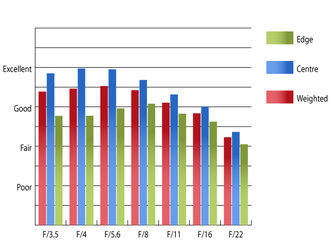 Resolution @ 18mm | 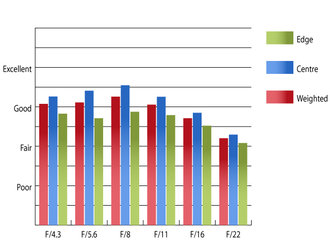 Resolution @ 35mm | |
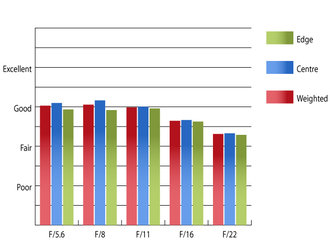 Resolution @ 55mm | How to read our chartsThe blue column represents readings from the centre of the picture frame at the various apertures and the green is from the edges. Averaging them out gives the red weighted column.The scale on the left side is an indication of actual image resolution. The taller the column, the better the lens performance. Simple. For this review, the lens was tested on a Samsung NX11 using Imatest. |
Levels of chromatic aberrations are low throughout the zoom range, except at 18mm, with the lens stopped down beyond f/11. Here CA levels start to rise beyond what may start to become an issue.
Falloff of illumination towards the corners of the frame is remarkably well controlled with corners only being 0.2 stops darker than the image centre at 18mm and f/3.5 and visually uniform at 55mm and f/5.6. These levels of vignetting are so low that it will be very rare that any correction will be necessary.
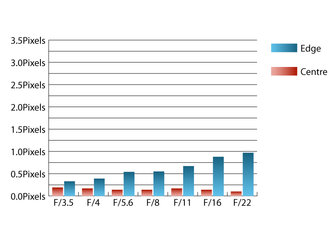 Chromatic aberration @ 18mm | 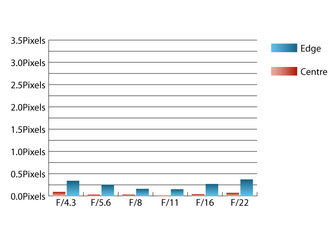 Chromatic aberration @ 35mm | |
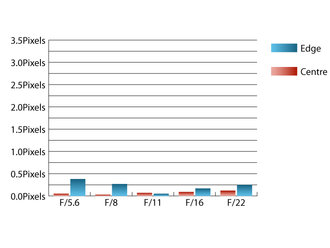 Chromatic aberration @ 55mm | How to read our chartsChromatic aberration is the lens' inability to focus on the sensor or film all colours of visible light at the same point. Severe chromatic aberration gives a noticeable fringing or a halo effect around sharp edges within the picture. It can be cured in software.Apochromatic lenses have special lens elements (aspheric, extra-low dispersion etc) to minimize the problem, hence they usually cost more. For this review, the lens was tested on a Samsung NX11 using Imatest. |
Barrel distortion at 18mm is extremely low at only 0.493%, but unfortunately quite disturbingly high levels of pincushion distortion are present at 55mm. Imatest detected 13.2% pincushion distortion, which can look highly unnatural in certain circumstances. The distortion pattern is uniform across the frame throughout the zoom range, so it should be relatively easy to correct in image editing software afterwards.
Add your message
Login required
Please login here or if you've not registered, you can register here. Registering is safe, quick and free.
Please login here or if you've not registered, you can register here. Registering is safe, quick and free.
photodo Stats
1102 lenses
428 MTF tests
74 in-depth photodo reviews
100+ users join each day
Help the lens community by reviewing or rating a lens today via our lens search
428 MTF tests
74 in-depth photodo reviews
100+ users join each day
Help the lens community by reviewing or rating a lens today via our lens search
Latest Lens Reviews
- Chinon 28mm f/2.8 Vintage Lens Review
- Canon EF 70-200mm f/4L IS II USM Lens Review
- Samyang AF 85mm f/1.4 EF Review
- Sigma 70mm f/2.8 DG Macro Art Review
- Samyang AF 24mm f/2.8 FE Review
- Meike 50mm f/1.7 Review
- Tamron 70-210mm f/4 Di VC USD Review
- Lensbaby Burnside 35mm f/2.8 Review
- Asahi Super Takumar 50mm f/1.4 Review
- Asahi Super-Multi-Coated Takumar 135mm f/3.5 Review
